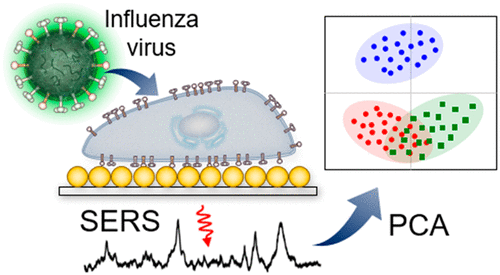2019. Jae-young Lim, Jung-soo Nam, Hyunku Shin, Jaena Park, Hye-in Song, Minsung Kang, Kwang-il Lim*

Rapid diagnosis and quarantine of influenza virus mutant-infected people is critical to contain the fatal viral infection spread because effective antiviral drugs are normally not available. Conventional methods, however, cannot be used for the diagnosis because these methods need predefined labels, likely also unavailable for just emerging viruses. Here, we propose label-free identification of cells infected with different influenza viruses based on surface-enhanced Raman spectroscopy (SERS) and principal component analysis (PCA). Viral envelope proteins that are displayed on the surface of cells after infection of influenza viruses were targeted for this identification. Cells that expressed the envelope proteins of A/WSN/33 H1N1 or A/California/04/2009 H1N1 influenza viruses produced distinct SERS signals. Cells that displayed combinations of the envelope proteins from these two viral variants, an indication of emergence of a new virus, also generated characteristic SERS patterns. However, the cell’s own surface proteins often hindered the identification of virally infected cells by producing SERS peaks similar to viral ones. PCA of the obtained SERS patterns could effectively capture the virus-specific signal components from the jumbled SERS peaks. Our study demonstrates a potential of combination of SERS and PCA to identify newly emerging influenza viruses through sensing the cells infected with the viruses.
PMID: 30829035 DOI: 10.1021/acs.analchem.8b05533











